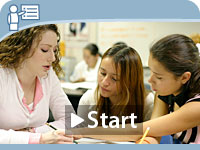Practice Overview
Develop academic English competence beginning in the primary grades.
Academic English is the formal language of school-based learning, the academic disciplines, and reasoned discourse. It includes reading, writing, speaking, and listening. more >>
What the research has shown
According to the expert panel, there is limited empirical evidence but a strong consensus among experts that English learners benefit from explicit instruction in academic English, beginning in kindergarten. more >>
Teaching Academic English to English Learners
This presentation explains the concept of academic English and why it is important. It emphasizes teaching academic language throughout the day, in content area classes, English language development classes, and reading classes. (8:45 min)
Practice Explanation
Academic English is the formal language of classrooms, colleges, and the workplace. More formal, nuanced, and de-contextualized than conversational English, academic English entails a high degree of precision in reading, writing, listening, and speaking. It entails understanding the structure of the language and the precise way in which words and phrases are used, including content-specific vocabulary.
Starting in kindergarten, academic English should be taught explicitly in specific blocks of time throughout the day—during content area instruction, reading instruction, and English language development. Students should learn the structure of the language, grammar, how words and phrases are used. They need to learn the technical vocabulary in content areas (e.g., “perimeter” in math) as well as general academic words like “compare and contrast.”
EXAMPLE: When a student purchases a newspaper, he uses his conversational language skills. For example, he greets the clerk and asks to make the purchase. In contrast, other skills altogether are used to read and understand the front-page article, as well as to discuss the pros and cons of the proposed policy change that the article describes. The oral and written language required to engage in the latter “conversation” involves more advanced and specialized vocabulary, and more complex sentence and discourse structures. (adapted from Francis, D., et al., 2006)
Research Evidence
Level of Evidence: Low
The low level of evidence rating assigned by the expert panel is based on the fact that there is little empirical research on the topic. Two studies reviewed by the What Works Clearinghouse demonstrate that focused interventions in two narrow areas of academic English (quality of oral narrative and syntax) are potentially effective. However, because the studies address very selective aspects of academic English, we cannot conclude that the studies affirm the effectiveness of instruction of academic English at this time. Additional support is provided by a recent classroom observational study that correlates devotion of specific blocks of time to English language development in kindergarten with enhanced outcomes.
Despite the limited experimental research, the strong consensus of expert opinion is that English learners require considerable explicit and deliberate instruction to learn the features of academic English. This consensus applies to the importance of teaching academic English from the earliest grades.
Key Research
1. Scientific Learning Corporation (2004).
Improved language skills by children with low reading performance who used FastForWord language; Maps for Learning
MAPS for Learning, 3, 1-13.
This study of Fast ForWord was conducted with K-5 English learners and assessed three aspects of comprehension of oral language that encompass three domains: word classes and relations; grammatical morphemes; and elaborated sentences. The effect size across these three areas was statistically significant.
——————————————————————————–
2. Uchikoski, Y. (2005).
Narrative development in bilingual kindergarteners: Can Arthur help?
Developmental Psychology, 41, 1012-1020.
This randomized control study investigated the effects of Arthur on development of English learners’ narrative skills. Narrative was defined in the study as at least two sequential independent clauses describing a single past event. The What Works Clearinghouse reviewed this intervention and rated its effects as potentially positive.
——————————————————————————–
3. Saunders, W. M., Foorman, B. P., & Carlson, C. D. (2006).
Do we need a separate block of time for oral English language development in programs for English learners?
The Elementary School Journal, 107, 181-198.
This observational study of kindergarten classrooms found that less than 7% of the time was spent on development of academic vocabulary and language. Student growth in oral language was stronger in classrooms where a specific block of time was designated for English language development.
Expert Interviews
Classroom Applications of Academic English
Robin Scarcella, Ph.D.
University of California at Irvine
Dr. Scarcella, the developer of a framework for understanding multiple dimensions of academic language, defines and discusses the importance of academic English. (5:13 min)
Download or Play Extended Video – Quicktime | 40 MB | 14:01 min
Download Transcript & Details – PDF | 172 KB
Key Actions
1. Work from standards to organize a framework and materials for teaching academic English.
Teachers need guidance about where to focus instruction. Ideally, school staff work together to analyze standards and textbooks to identify the most critical academic language in each content area at each grade level. Staff can then add supplemental content relevant to their students’ language background, and review assessment data to determine what additional academic English instruction their students need.
——————————————————————————–
2. Teach academic English throughout the day.
Academic English should be taught in content area classes and in English language development classes as well as core reading classes. The strongest models coordinate instruction in academic English across these settings so that students preview, learn, and practice academic English as they learn content from grade-level (not simplified) text.
——————————————————————————–
3. Address academic English development needs of students at all levels of English proficiency.
Instruction should take into account students’ English language proficiency levels. Beginning-level English learners will need greater support in understanding content and might demonstrate understanding using key words, pictures, or graphs. English learners at intermediate levels who have developed oral proficiency in English will still need support in specialized content vocabulary and more advanced skills such as expository writing.
——————————————————————————–
4. Provide teachers with professional development in teaching academic English.
Professional development must be ongoing and include extensive practical activities, such as deepening teacher understanding of what students need to know about academic English and analyzing student work to gauge what aspects of academic language give students difficulty and why. Teachers should also be given opportunities to practice instructional techniques, with feedback from a coach or more experienced peer.
Links
NCELA Page on Academic Language
The resources section of the National Clearinghouse for English Language Acquisition website defines academic English and provides links to key resources and research studies.
——————————————————————————-
Robin Scarcella Presentation on Academic English
This PowerPoint presentation, accessed from the NCELA resources page, was given by Robin Scarcella at a 2006 conference on “Academic Language: Integrated Proficiency Standards for English Language Learners in Texas.”
——————————————————————————–
Kate Kinsella Keynote at 2006 OELA Summit
Kate Kinsella delivered a keynote on “Essential Features of Structured, Inclusive Academic Discussions” at the Office of English Language Acquisition Summit in 2006. A PDF of detailed instructional strategies is available.
——————————————————————————–
Focused Interventions Reviewed by the What Works Clearinghouse.
This topic report summarizes in a colorful table the different interventions reviewed by the What Works Clearinghouse and the effectiveness of each for reading achievement and English language development.
——————————————————————————–
Developing literacy in second-language learners: Report of the National Literacy Panel on Language-Minority Children and Youth.
The findings of the National Literacy Panel on Language-Minority Children and Youth. A distinguished group of expert researchers in reading, language, bilingualism, research methods, and education was charged to identify, assess, and synthesize research on the education of language-minority children and youth and their attainment of literacy.
——————————————————————————–
Research-based recommendations for instruction and academic interventions
This book is the first in a series of three Practical Guidelines for the Education of English Language Learners. Addressing both reading and mathematics, K-12, the recommendations apply to both a classwide instructional format and individualized, targeted interventions. A PowerPoint presentation from October 2006 is also available in PDF.
——————————————————————————-
Academic English: A conceptual framework
This report, accessed from the NCELA resources page, presents a multi-dimensional framework for analyzing academic English. The framework includes linguistic, cognitive, and socio-cultural/psychological dimensions. The report compares the English used in everyday situations and in academic ones. It also briefly discusses the research implications for instruction, assessment, and professional development.
Link to Site
Return Links
Return to “DEVELOP ACADEMIC ENGLISH” Page
Return to “PROVIDE READING INTERVENTIONS” Page
Return to “RECOMMENDED PRACTICE” Page
Return to Main Teaching Literacy Page


